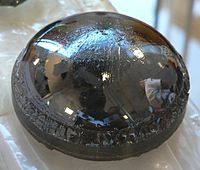
Photo from wikipedia
We demonstrate the merits of an unexplored precursor, tetrasilane (Si4H10), as compared to disilane (Si2H6) for the growth of defect-free, epitaxial hexagonal silicon (Si). We investigate the growth kinetics of… Click to show full abstract
We demonstrate the merits of an unexplored precursor, tetrasilane (Si4H10), as compared to disilane (Si2H6) for the growth of defect-free, epitaxial hexagonal silicon (Si). We investigate the growth kinetics of hexagonal Si shells epitaxially around defect-free wurtzite gallium phosphide (GaP) nanowires. Two temperature regimes are identified, representing two different surface reaction mechanisms for both types of precursors. Growth in the low temperature regime (415 °C-600 °C) is rate limited by interaction between the Si surface and the adsorbates, and in the high temperature regime (600 °C-735 °C) by chemisorption. The activation energy of the Si shell growth is 2.4 ± 0.2 eV for Si2H6 and 1.5 ± 0.1 eV for Si4H10 in the low temperature regime. We observe inverse tapering of the Si shells and explain this phenomenon by a basic diffusion model where the substrate acts as a particle sink. Most importantly, we show that, by using Si4H10 as a precursor instead of Si2H6, non-tapered Si shells can be grown with at least 50 times higher growth rate below 460 °C. The lower growth temperature may help to reduce the incorporation of impurities resulting from the growth of GaP.
Journal Title: Nanotechnology
Year Published: 2019
Link to full text (if available)
Share on Social Media: Sign Up to like & get
recommendations!